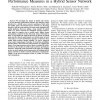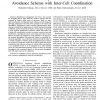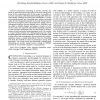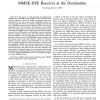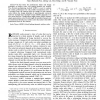TWC
2010
13 years 6 months ago
2010
We investigate the impact of mobile node density on several detection performance measures for stationary target detection by a hybrid sensor network consisting of both static and ...
TWC
2010
13 years 6 months ago
2010
We consider a multiuser two-way relay network where multiple pairs of users exchange information with the assistance of a relay node, using orthogonal channels per pair. For a vari...
TWC
2010
13 years 6 months ago
2010
Interference management has been a key concept for designing future high data-rate wireless systems that are required to employ dense reuse of spectrum. Static or semistatic interf...
TWC
2010
13 years 6 months ago
2010
This paper deals with distributed demodulation of space-time transmissions of a common message from a multiantenna access point (AP) to a wireless sensor network. Based on local me...
TWC
2010
13 years 6 months ago
2010
Cooperative forwarding in wireless networks has shown to yield rate and diversity gains, but it incurs energy costs borne by the cooperating nodes. In this paper we consider an inc...
TWC
2010
13 years 6 months ago
2010
Underwater multimedia acoustic sensor networks will enable new underwater applications such as multimedia coastal and tactical surveillance, undersea explorations, picture and vide...
TWC
2010
13 years 6 months ago
2010
An adaptive regenerate and forward cooperative diversity (CD) system using quadrature amplitude modulation (QAM) for a two-user cooperation is proposed. The proposed system can ach...
TWC
2010
13 years 6 months ago
2010
In this paper, we study multi-hop non-regenerative multiple-input multiple-output (MIMO) relay communications with any number of hops. We design the optimal source precoding matrix...
TWC
2010
13 years 6 months ago
2010
The goal of this paper is to explore the benefits of channel diversity in wireless ad hoc networks. Our model is that of a Poisson point process of transmitters, each with a recei...
TWC
2010
13 years 6 months ago
2010
In this letter the performance limits and design principles of rateless codes over fading channels are studied. The diversity-multiplexing tradeoff (DMT) is used to analyze the sys...
